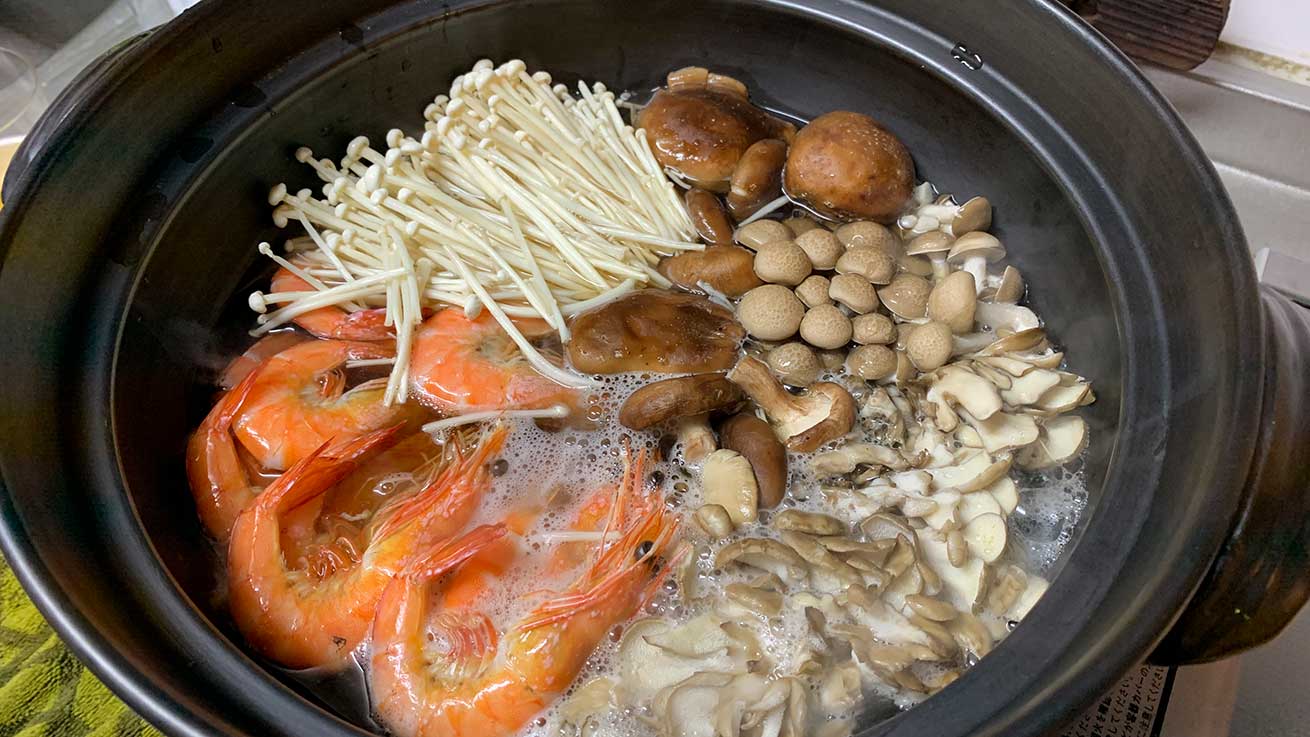
Celebrating Oshogatsu, a Traditional Japanese New Year
The biggest holiday of the year in Japan is not some summer matsuri, or Golden Week, the Emperor’s birthday, or Sakura Hanami. The biggest holiday of the year is Oshogatsu or New Year. It is a three-day national holiday, from January first to January third. Christmas is different in Japan. Likewise, the New Year holiday takes on a whole new meaning here. Observant readers will already have noticed that New Year’s Eve is not part of Oshogatsu. And there are many other differences as well. Let me fill you in on some of the details and tell you how Coco and I celebrated a traditional Japanese New Year.
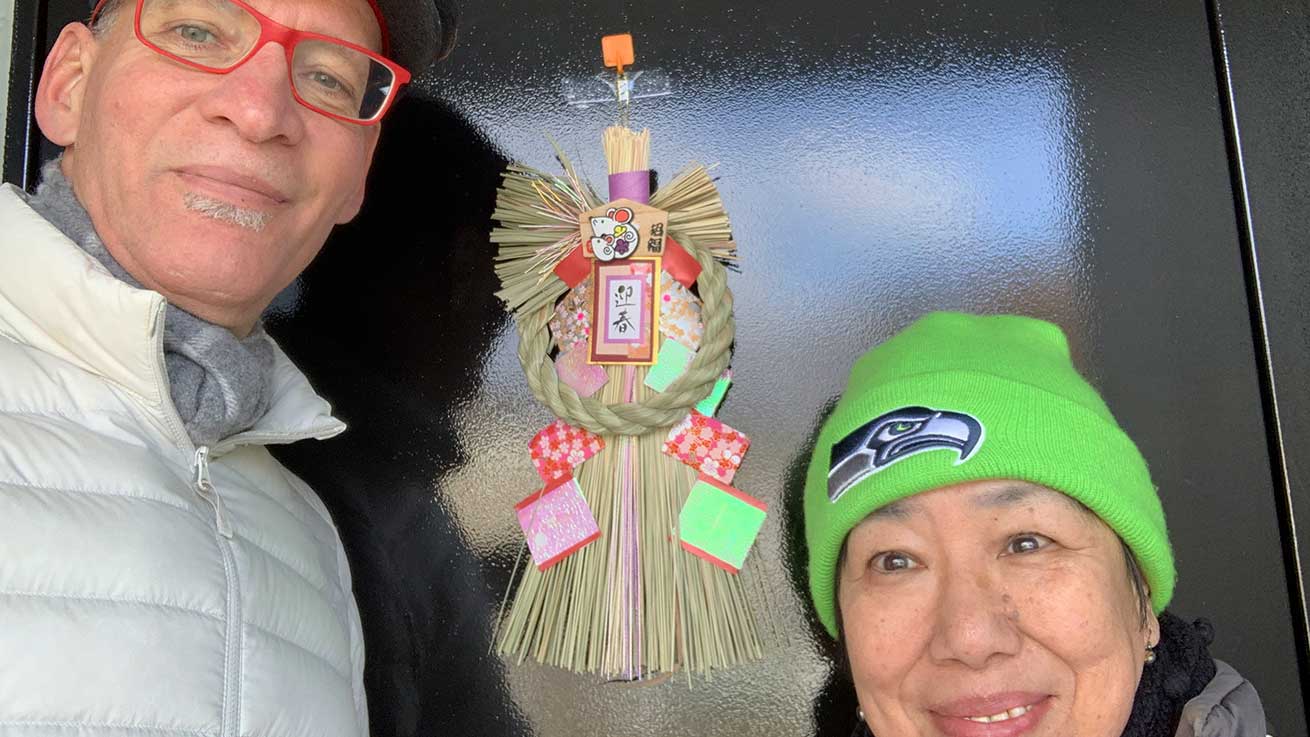
Preparing for Oshogatsu
While Japan is not a Christian country, and Christmas is not a holiday here, some stores do decorate for Christmas. But only until December 25th. When Coco and I were out on Christmas Day, we noticed shop clerks taking down the decorations from shelves and displays. And walking home that evening, we saw crews stripping off the Christmas banners from buildings in downtown Sendai. This is all in preparation for Oshogatsu.
Oshogatsu Decorations
Once the Christmas decorations are taken down, traditional Japanese homes and businesses put up Oshogatsu decorations. It is considered unlucky to do so on December 29, since the number 9 is deemed to be unlucky. Leaving it to the last moment is not recommended either, which means many people decorate on December 28. There are several traditional decorations for both outside and inside your home or business.
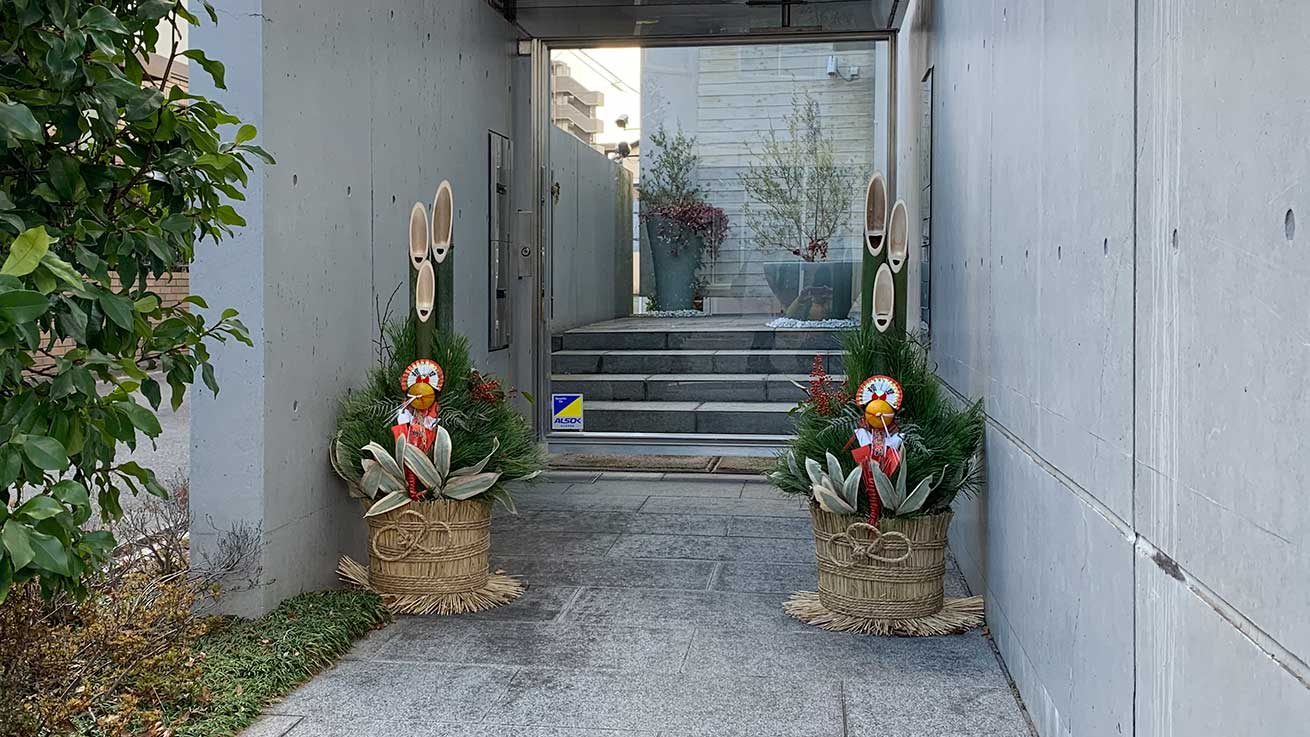
Kadomatsu
Kadomatsu are pine decorations placed in front of the gate to your home or business. They usually consist of three bamboo poles of different lengths cut diagonally; the tallest represents heaven, the middle pole humanity, and the shortest pole represents earth. Pine tree branches and sprays of plum trees are fastened to the poles with a new straw rope. Pine is a symbol of longevity, and it is said that the gods descend to it. Since we live in an apartment, we don’t really have the right place to put two Kadomatsu. But we have another option.
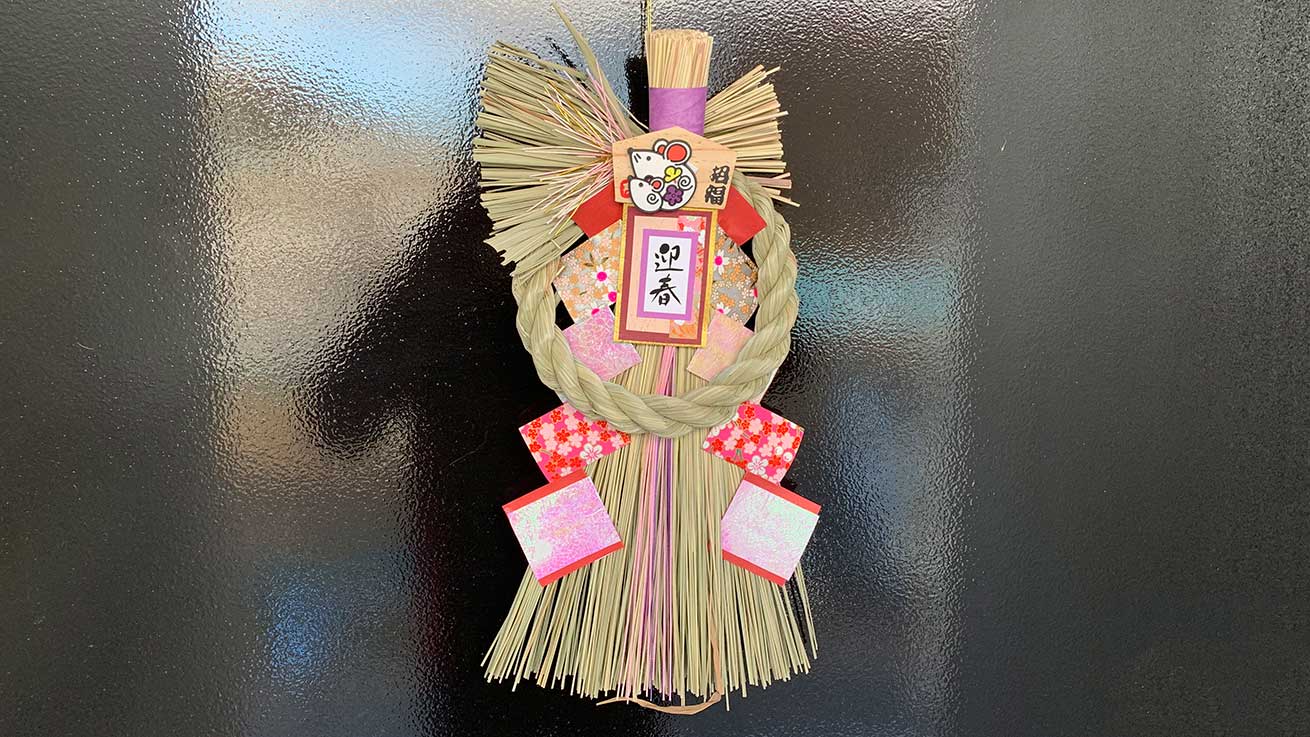
Shimekazari
Another type of Oshogatsu decoration are Shimekazari. They are different forms of Shimenawa, the straw ropes decorating sacred places, such as a shrine. Japanese decorate the front doors of their homes and businesses with Shimekazari to ward off evil spirits and invite the Toshigami to visit and bless the home or business with good fortune. The Kami are believed to reside in the Shimekazari while they visit and bless your home. To free them, Shimekazari are burned in bonfires at shrines after the New Year’s period.

Kagamimochi
Kagamimochi are sets of two round, flat rice cakes. A smaller one is placed on top of the larger one. Mochi have always been considered a sacred food in Japan. Kagamimochi are placed in the tokonoma, or sacred alcove, and offered at a Shinto altar inside Japanese homes. Kagamimochi are also believed to protect your home or business from fire. Since we have only a small apartment, we only have one Kagamimochi. But in larger homes, it is not uncommon to have one in each room.
Omisoka
As I already mentioned, New Year’s Eve is not a holiday in Japan, and it is not part of Oshogatsu in that sense. But it does have meaning for the Japanese New Year.
Osoji
On New Years’ Eve, families come together for Osoji or the “Big Cleaning.” In Shintoism, you must clean out any dirt or leftovers from the old year before you can start the new one. In other words, with a thorough cleaning, you have a fresh start for the new year. Coco and I had two Osoji, one in our own home, and one at our family home in Nakayama. The latter included washing all the dishes in the kitchen cabinets, and even light bulbs and light fixtures. Talk about a thorough cleaning!
Preparations for Osechi Ryori
Omisoka is also the last day for preparations for Osechi Ryori, the traditional New Year’s Day feast. Since Oshogatsu is the biggest holiday of the year, all stores and businesses will be closed, some of them for three days. As a result, shops and especially the Asaichi Market or packed with shoppers picking up the last ingredients. Our traditional Japanese New Year’s always includes a visit to the market, a few fresh oysters, and a Yaki-Imo or two! You need to keep up your strength for the events ahead.
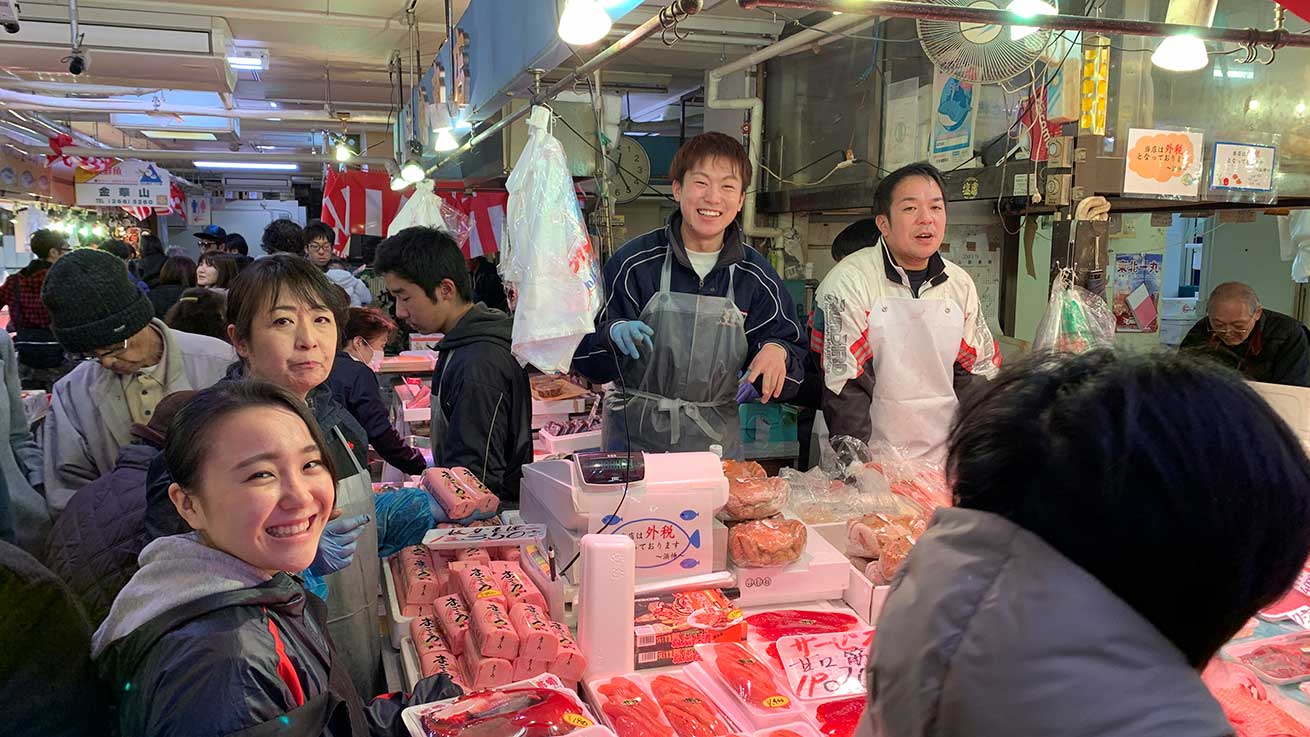
Remembering Your Ancestors
An essential part of a traditional Japanese New Year is to remember your ancestors. As part of our Omisoka rituals, we made sure to include our loved ones who are no longer with us. We left food and drink offerings for them at the Shinto altar at our family home in Nakayama. And we prayed that the deities would provide them with guidance and good fortune. By doing so, we not only honored ancient traditions; we also felt closer to their spirits for the holidays.


Eating Toshikoshi Soba
A traditional Japanese New Year would not be complete without eating Toshikoshi Soba for your last meal of the year. This was one of our traditions, even when we still lived in Seattle. The extra-long noodles are supposed to give you a long life, and who wouldn’t want that?
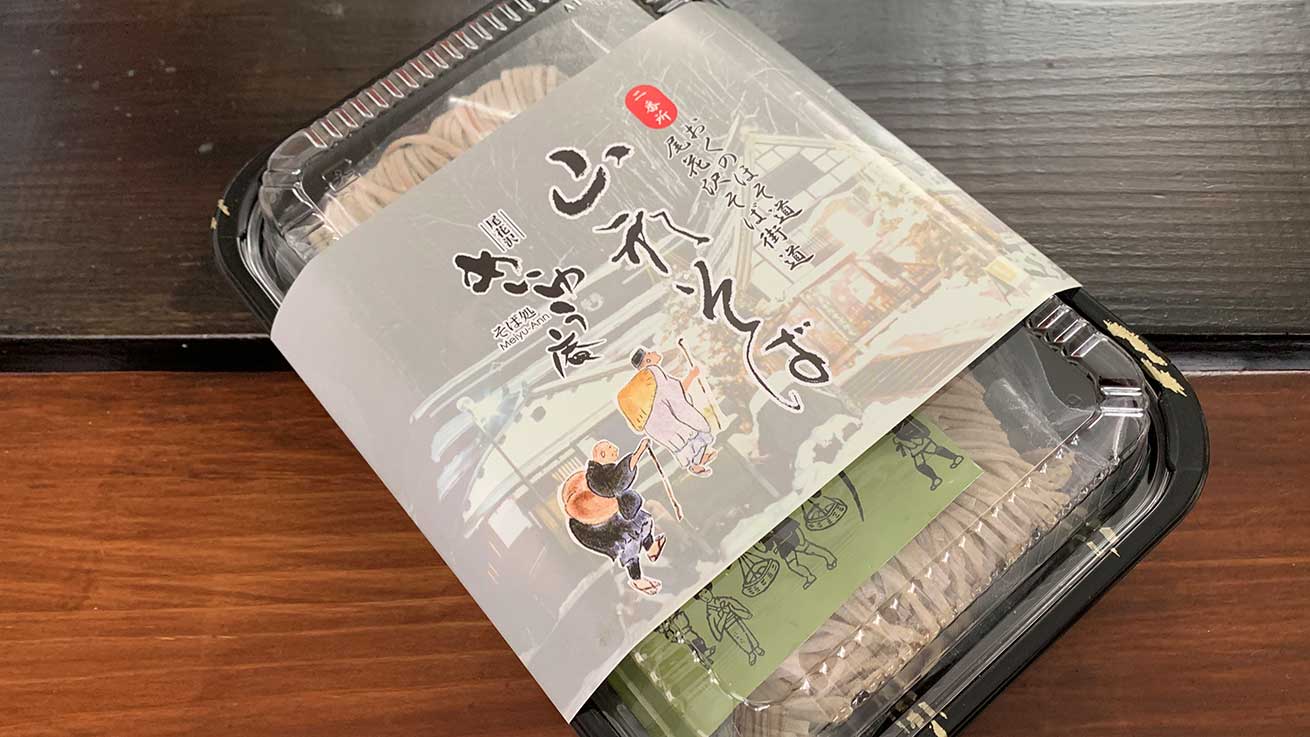
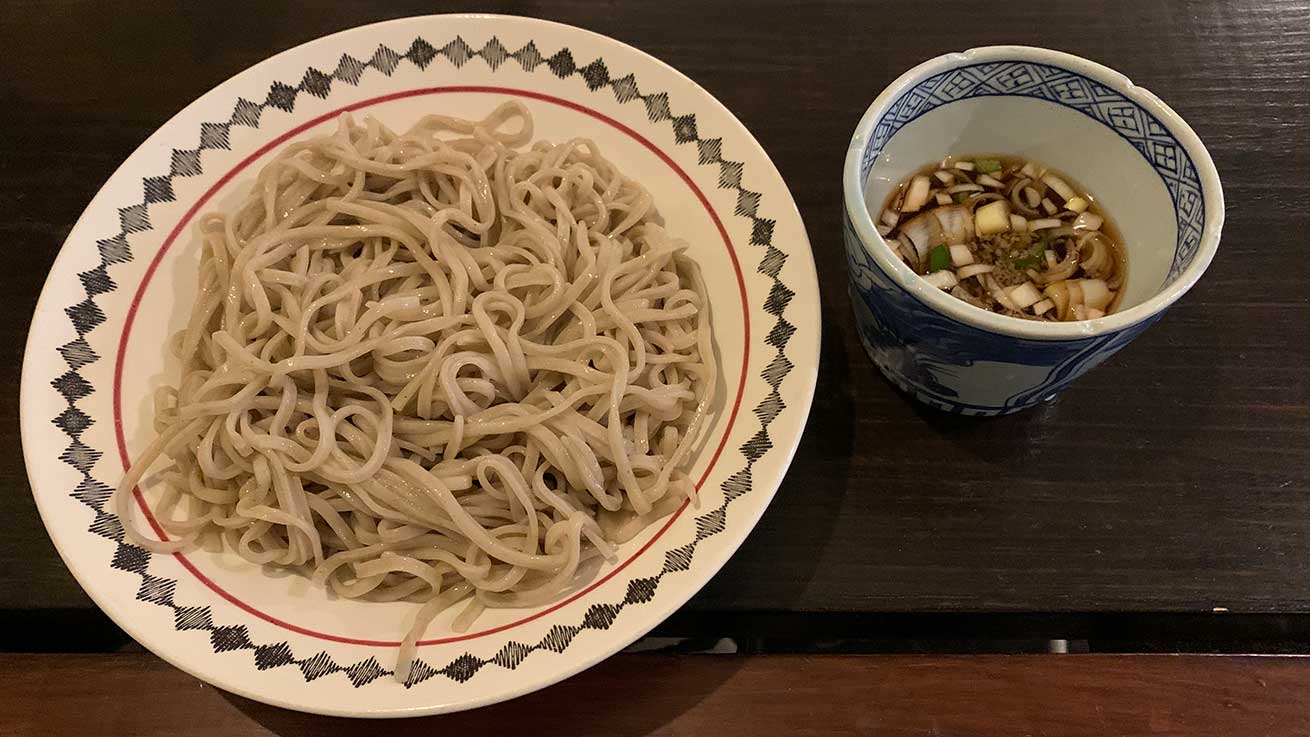
Oshogatsu, a Traditional Japanese New Year
Oshogatsu, or a traditional Japanese New Year, is rooted in ancient Shinto traditions and rituals. Some of you may not realize this, but neither Coco nor I are Christian. We are both firm believers in Shintoism. And while this was technically our second New Year’s in Sendai, this was the first time we observed all the traditional Shinto traditions. And that was very important for us.
Oshogatsu is Rooted in Shintoism
Shintoism is less of a religion and more of a way of life in Japan. It is based on two elementary principles, “Living in harmony with all living things.” and a “Spirit of mindfulness of others.” Shinto shrines are in every neighborhood in Sendai. We frequently visit them to make offerings and say a prayer. And so do lots of other people of all ages.
One of the core beliefs of Shintoism is that the deities are all around us and have a direct bearing on our fortunes. Different spirits, or Kami, guide and help us in different ways. But to keep the spirits on your good side, so to say, you need to follow specific rules. This is especially important during the New Year’s period, when the Toshigami, or New Year’s Gods, come to visit earth.
Hatsumode
As part of a traditional Japanese New Year, it is essential to visit a shrine during the first three days of the year. This is when you get together with family and friends to pray for good fortunes. More prominent shrines usually have organized festivities. Often they include food vendors and those that sell Omikuji or fortune-telling strips of paper to wish for prosperity, good health, luck for exams, and even love.
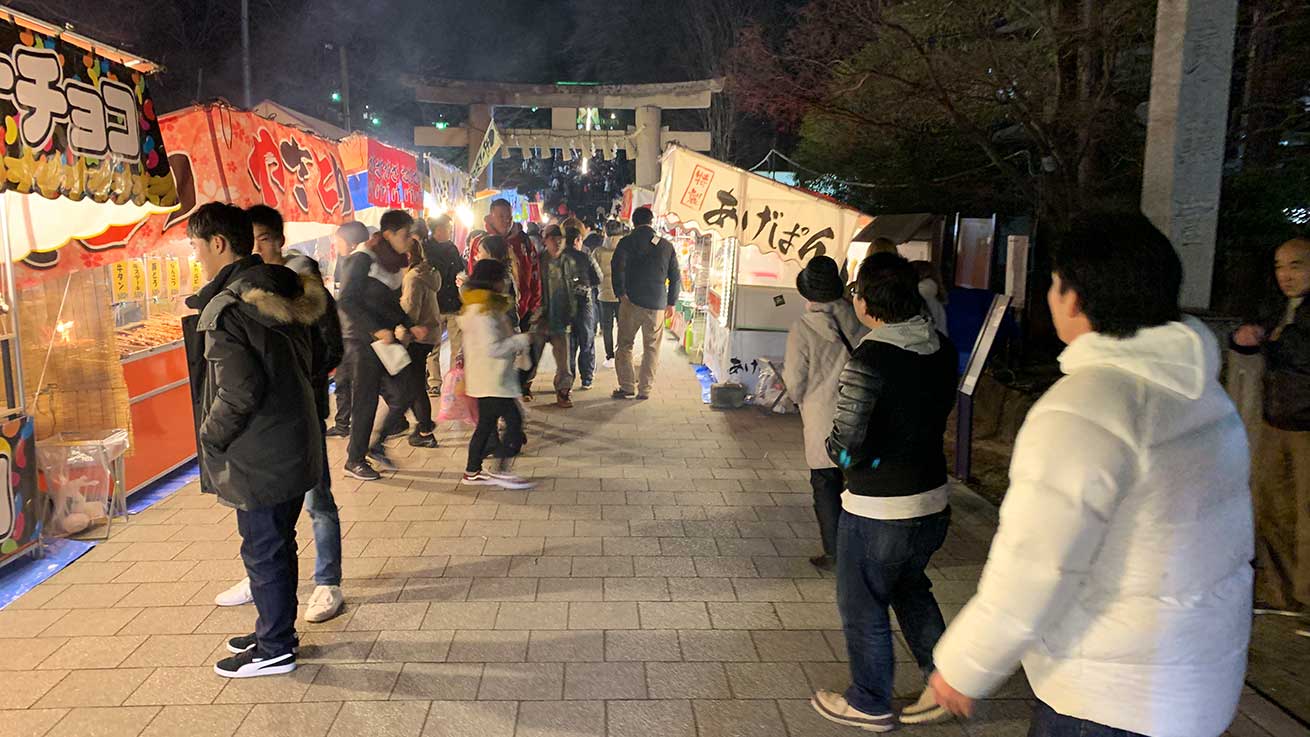
Since we live only a short walk from Toshogu Shrine, Coco and I set out shortly after finishing our Toshikoshi Soba. It was a very serene and spiritual experience to walk through the cold, silent winter night, only hearing the bells ringing Joya no Kane. This Buddhist tradition of ringing the temple bells 108 times is thought to remove the 108 different earthly desires or Bonnou.

Things got busier as we reached the entrance to Toshogu Shrine just before midnight. Well over a thousand worshippers were already lining the steps leading up to the main gate. More were arriving by the minute. We were especially surprised at how many young people were in the crowd.
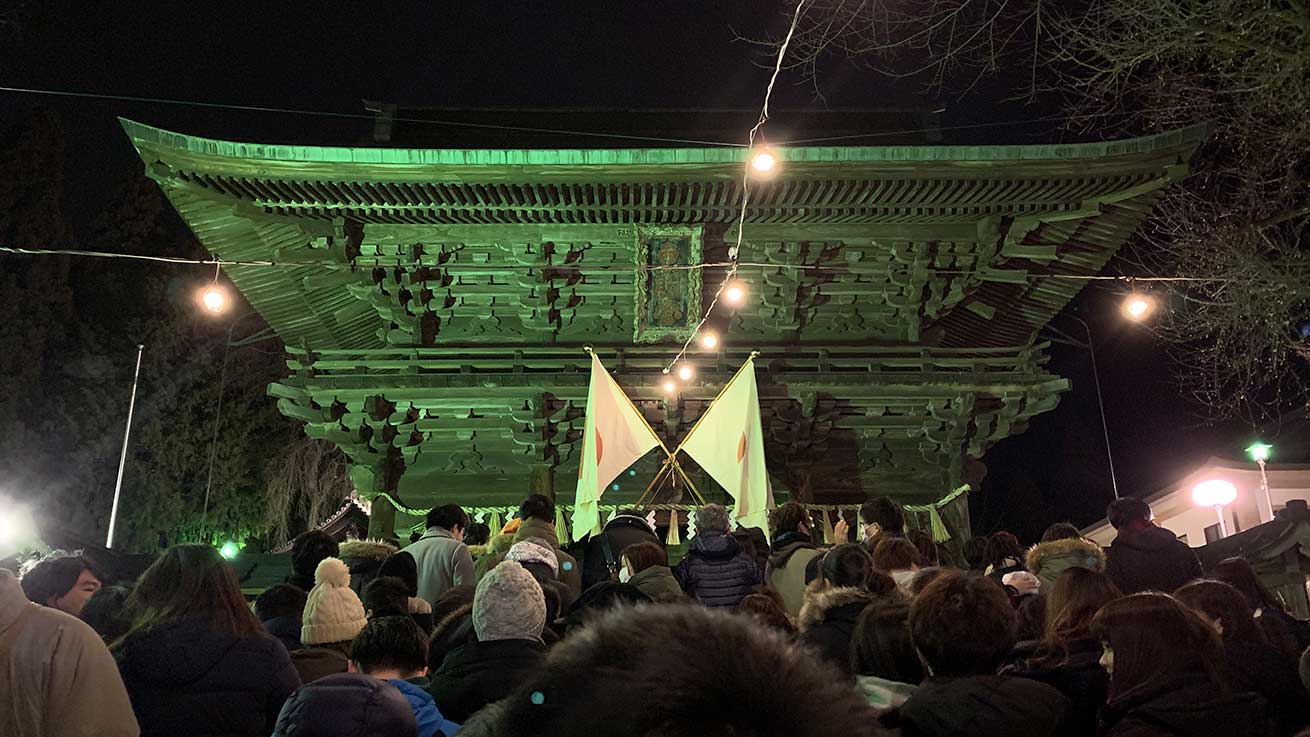
In typical Japanese fashion, the crowd slowly, but steadily, advanced up the stone steps. Adults, children, and even small dogs patiently awaited their turn to pray to the deities and make the appropriate offerings. Quiet conversations centered around how cold it was, and the expectations for the new year. As we climbed higher, we could see ever more people lining up further down the steps.
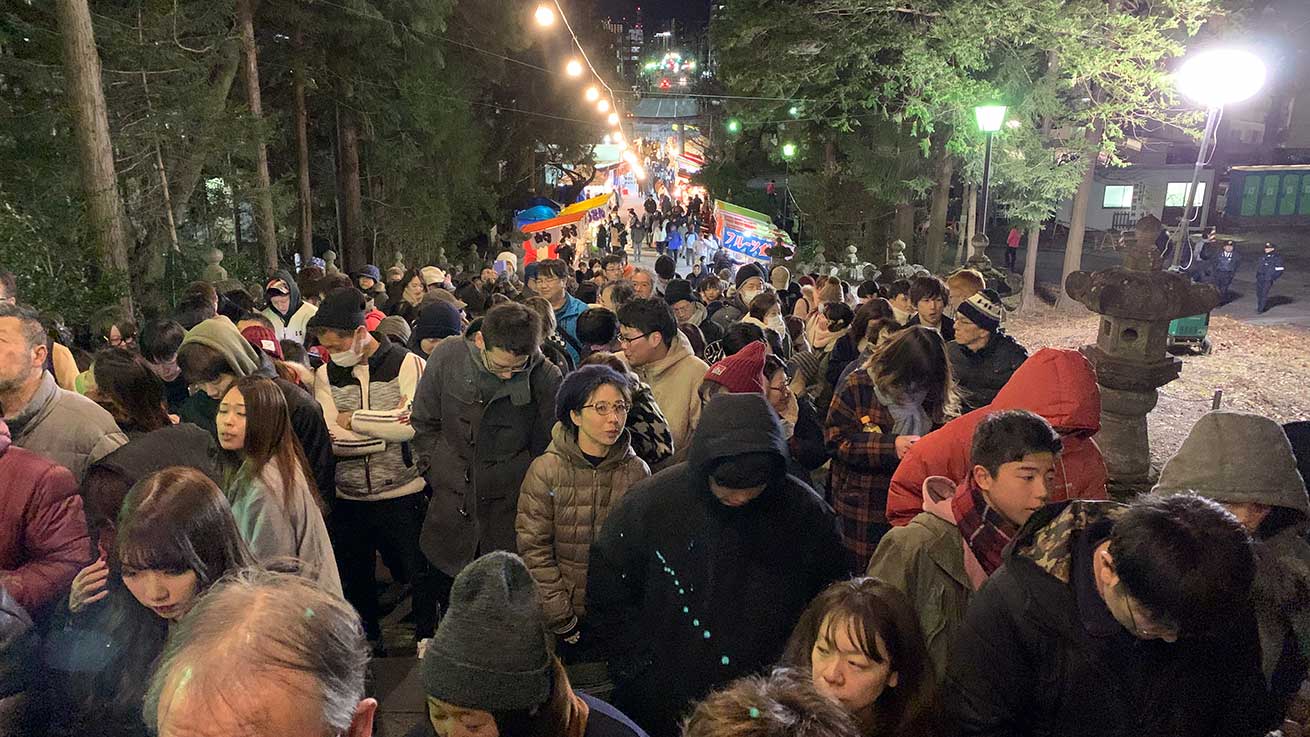
Prayers and Offerings
Once we passed through the main gate security guards allowed us up the final set of steps in organized groups of about 60 people each. Lined up in six rows, each person followed the same ritual:
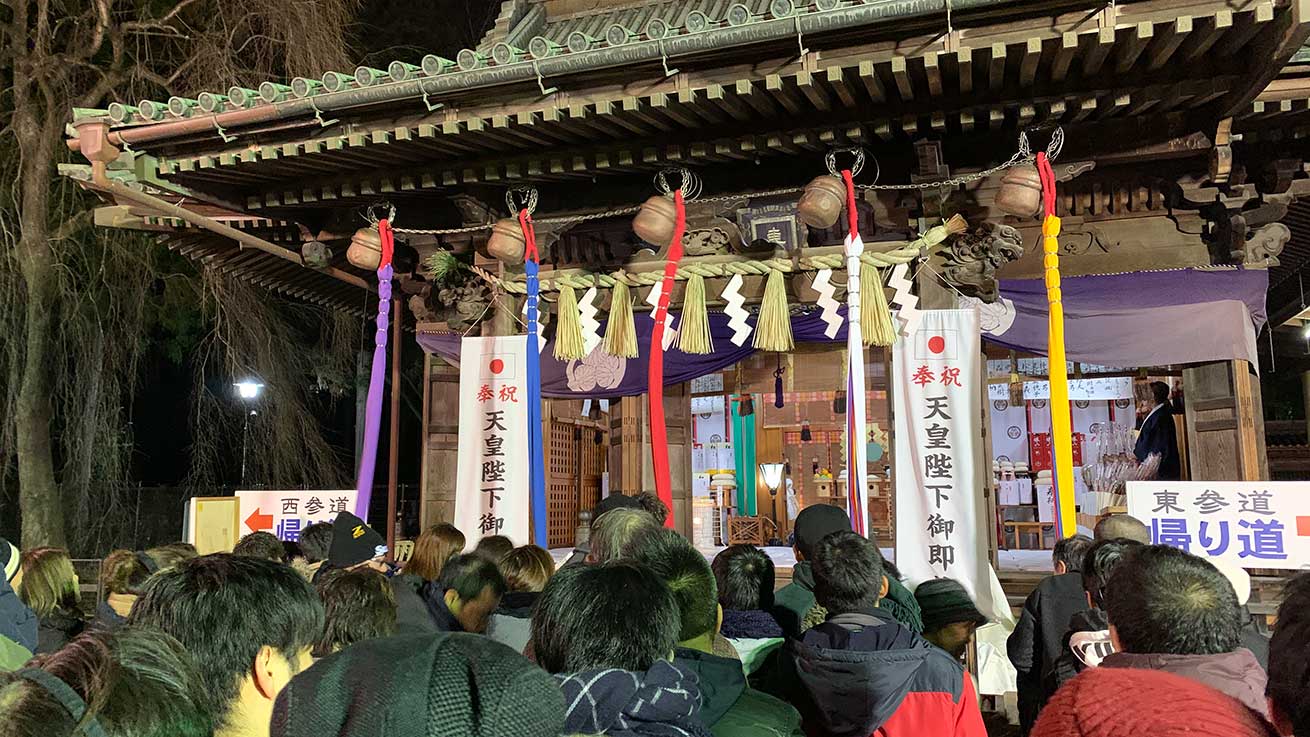
- Toss a coin into the collection box
- Ring the bell
- Bow twice
- Clap your hands twice to announce your presence to the deity
- Bow once and step aside

For both of us, it was a profoundly moving and spiritual experience. As we said our prayers, we reflected on our good fortune to be together in our new homeland. We felt happy, at peace, and indeed at home. Coco and I look forward to making this a regular part of how we celebrate Oshogatsu. But now we had to get home and get a few hours of sleep before the next ritual.
Hatsushinode
Well before dawn on January first we got up and headed out into the freezing winter morning. Coco was half asleep as she trudged along. But we were both determined to participate in the next Oshogatsu ritual, Hatsushinode. You may have noticed that the Japanese word “hatsu” means first. We already made our first shrine visit. Now we were off to greet the first sunrise of the new year.

According to Shintoism, the Toshigami, or New Year’s gods, arrive on earth with the first sunrise of the year. If the Toshigami see you when they arrive, they will bless you with good fortune for the year. Therefore, it is essential to bow to the first rising sun of the new year. One can never have too many blessings, after all!
Hiking up to Komatsushima
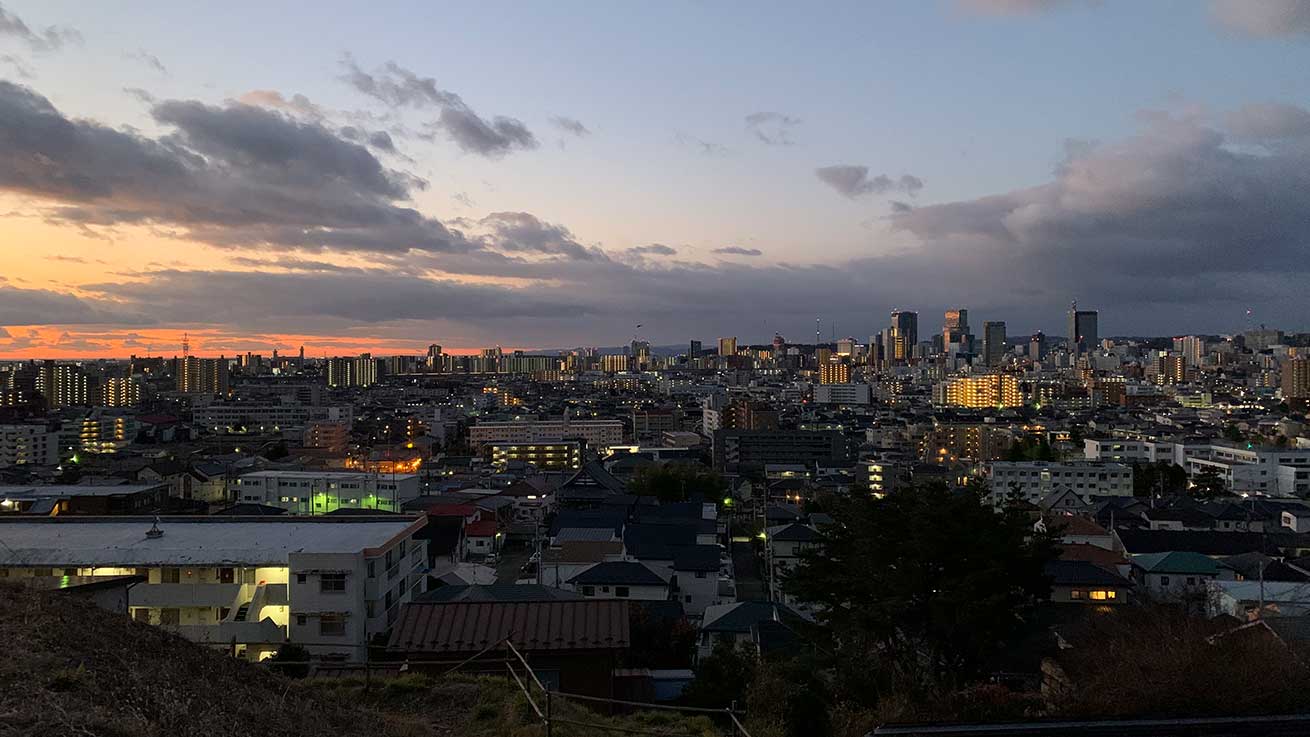
Coco and I discovered an ideal lookout spot on a walk a few months earlier. We explored a different part of our neighborhood and ended up on top of a hill in Komatsushima. Much of Sendai was spread below us. In the distance, we could see the ocean. We asked a passerby about the place, and he told us that many years earlier, it was a strawberry farm. Homes dot the hillside, but the top is relatively open. And we were told that on New Year’s Day, many people climb up to this spot to witness the sunrise.
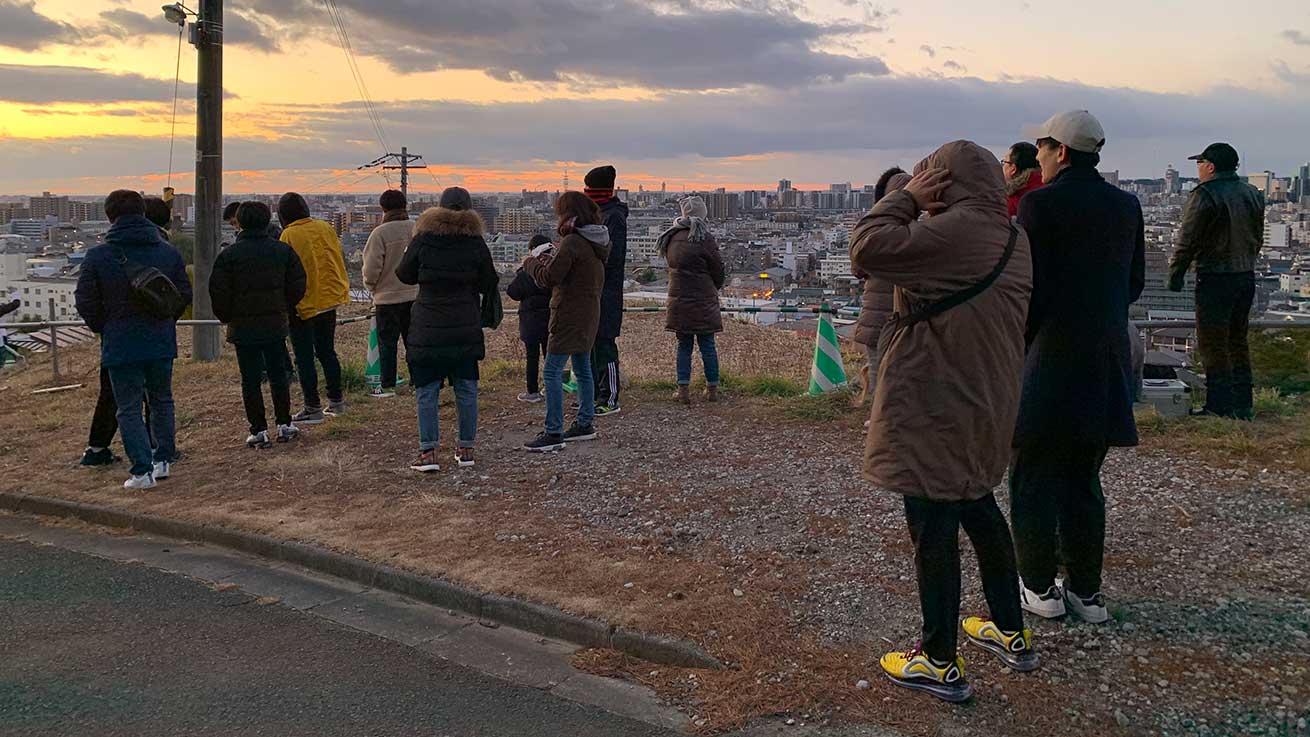
We made it to the top of the hill in plenty of time; a layer of clouds would delay the arrival of the sun a while longer. A few people had already gathered, and more were arriving. Judging by their conversations, this was an annual event. Many people seemed to know each other. And once again, we were surprised by how many young people braved the freezing cold.
The Arrival of the Toshigami
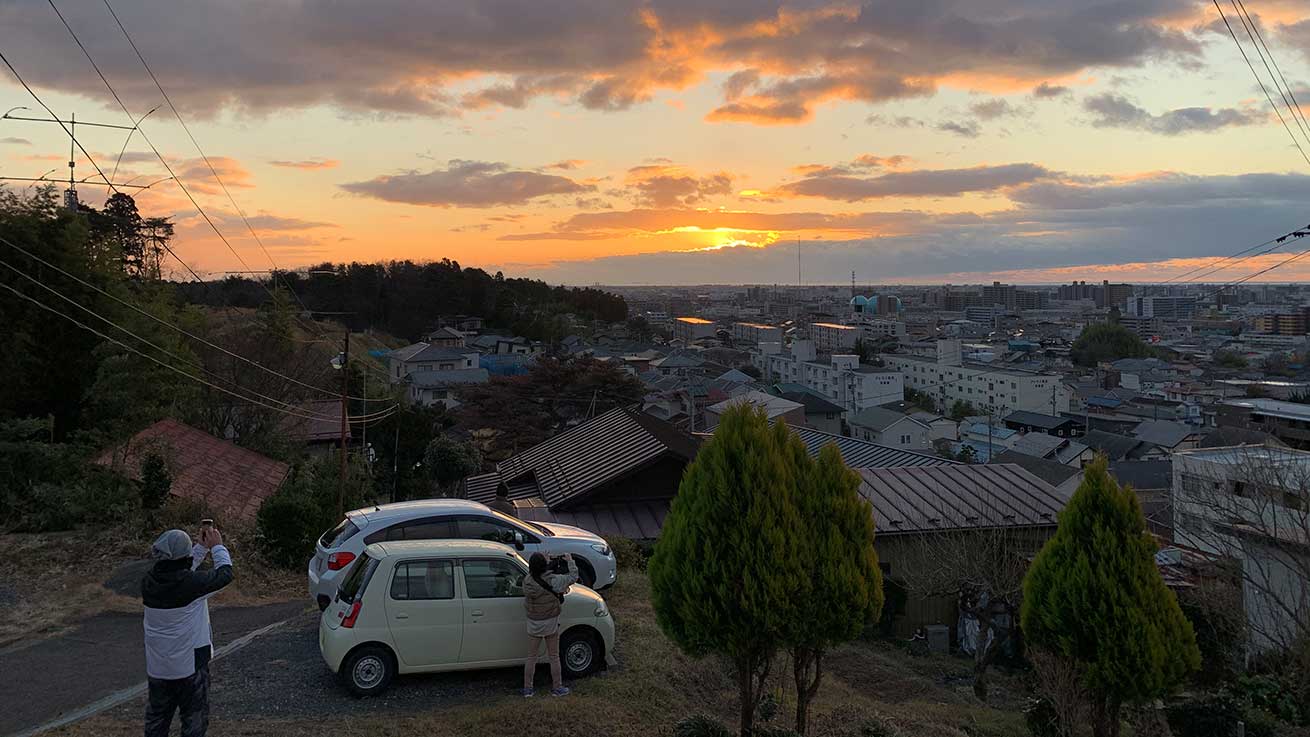
As sunrise approached, we could see the sky get brighter and brighter. The dusky orange hues started to take on a golden hue. And soon, we could see the glowing outline marking the spot where the sun would rise above the clouds. In typical Japanese fashion, smartphone and DSLR cameras were all aimed at the spot to catch the actual moment. In somewhat atypical fashion, people actually stepped over or around a low barrier to get a better viewing spot.

When the sun broke above the clouds, there was an audible sigh from the crowd. Pictures and selfies were taken and excitedly compared. I am sure a few silent prayers to the Toshigami were offered. Coco and I added our own. The experience was definitely worth being a little sleep-deprived and braving the freezing cold. For us, it was an extraordinary moment, the beginning of another exciting year ahead in Sendai. Feeling happy and full of positive energy, we walked home to our waiting bed.
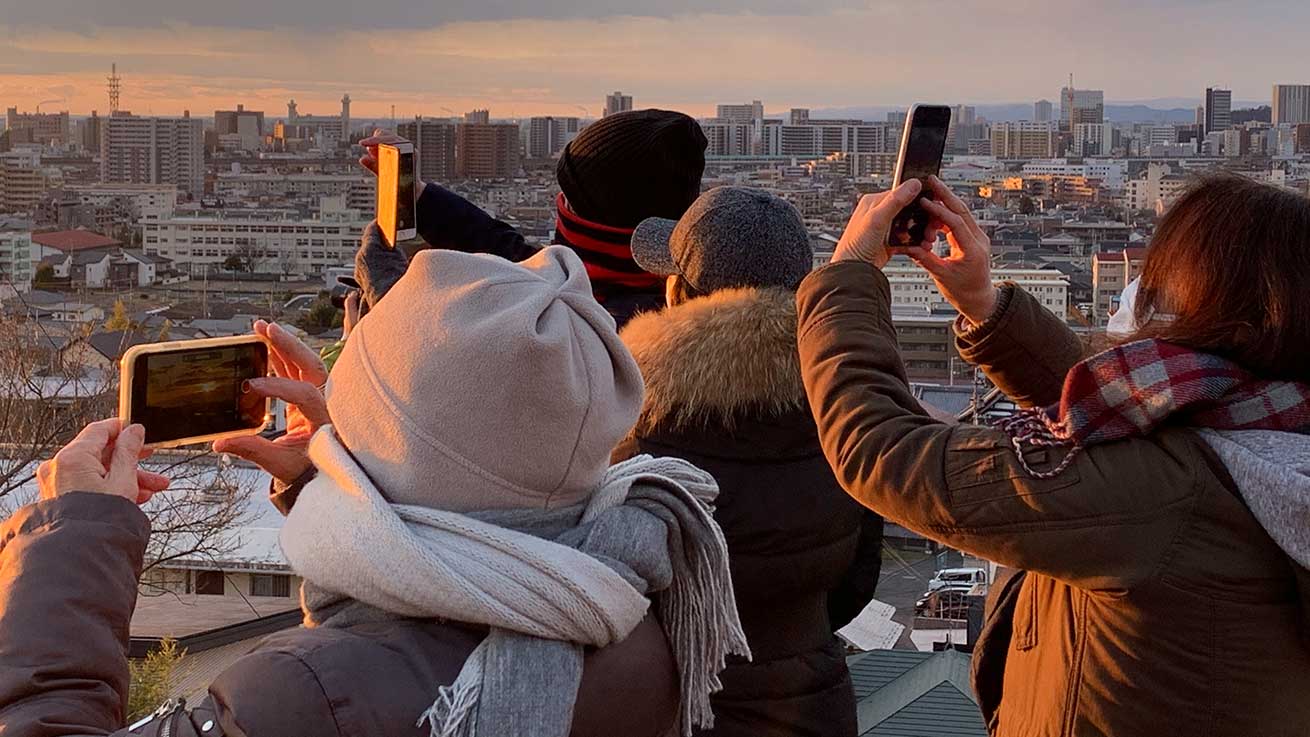
The Fun Part of Oshogatsu
You may think that a traditional Japanese New Year is a pretty solemn and ceremonial experience. And while there are definitely rituals and customs to be observed, that is by no means all there is to Oshogatsu. The best part is still ahead! Here in Japan, New Year’s is a family holiday. Instead of attending big parties (and getting drunk) you spend the holiday with family and close friends.
Osechi Ryori
In Japan, the first day of the year is spent in the company of family and friends, eating delicious food, and watching comedies on TV. The traditional belief is that all this love, laughter, food, and happiness will provide you with good energy for the entire year ahead. It definitely beats spending the first of the year nursing a hangover, or on your bathroom floor in front of the toilet. After all, the New Year’s Gods are not going to get a very good impression of you that way. Which means they are not likely to bestow good fortune on you either.
Some of you may remember that Coco always served a traditional Japanese New Year’s feast on January first. Osechi Ryori is a central part of Oshogatsu, and you spend a great deal of your day eating. You can get ready-made Osechi-Ryori from many stores here in Sendai. While this may look pretty, it is usually better and more fun to make your own.
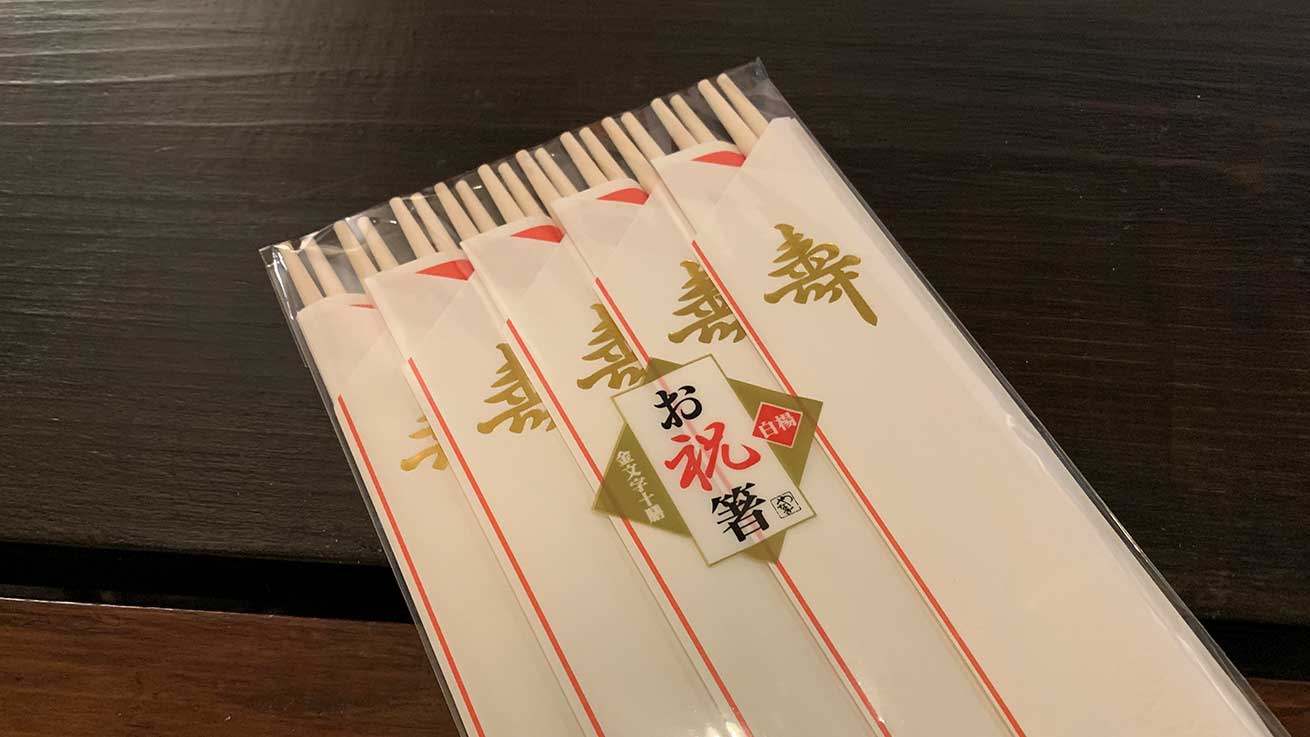
You should also use Iwai-Bashi or special chopsticks that are pointy on both ends. One end is for you, the other is for the deity. By offering the meal to the deity first, who will then share it with you, you will have a fruitful year ahead!
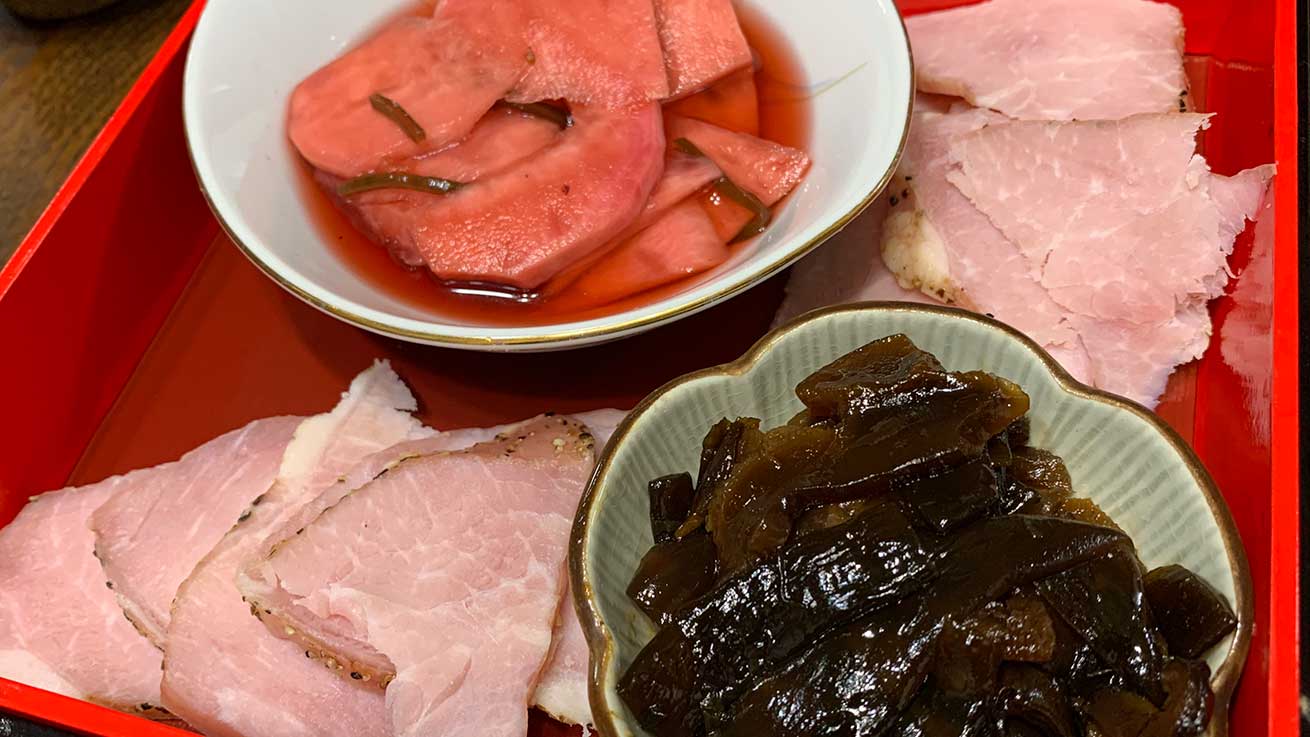
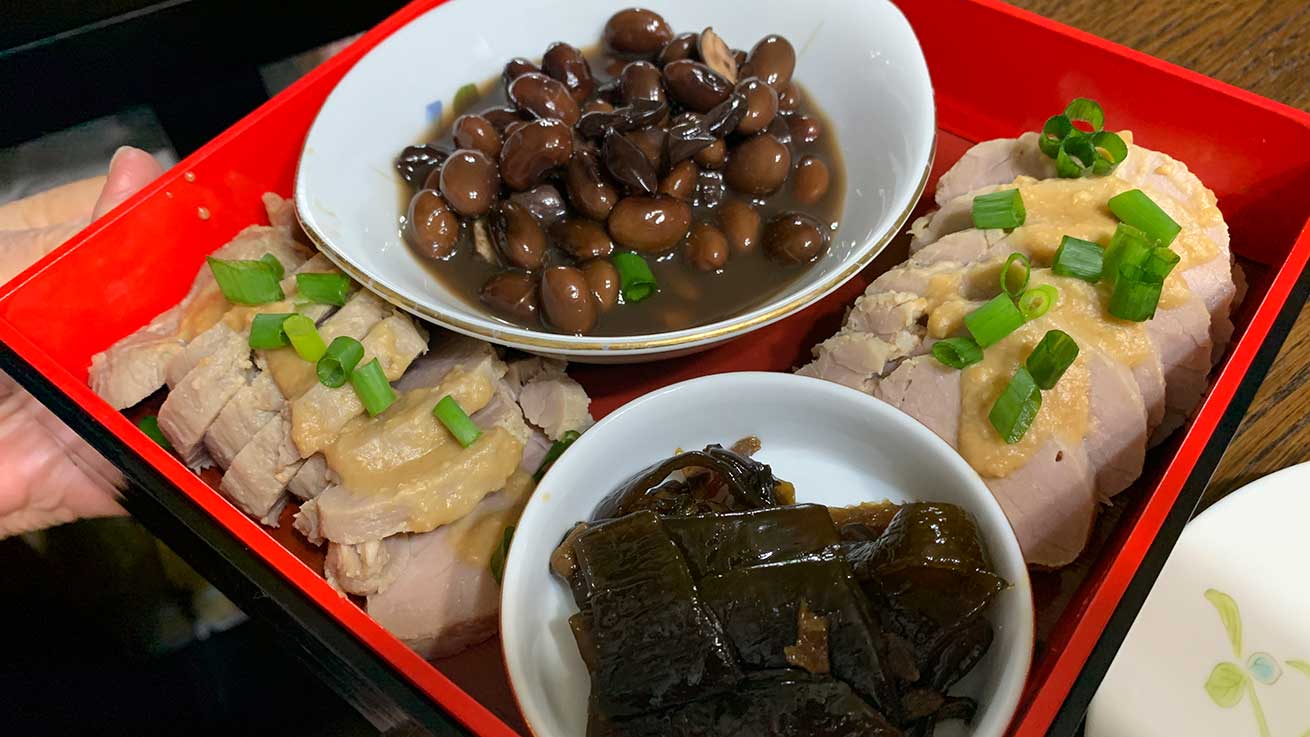
What exactly you eat as part of your Osechi Ryori is pretty much up to your own personal tastes. Our family loves food, so we had plenty. From a massive slab of tuna to seafood and mushroom nabe, and Coco’s pork marinated in Miso paste, we had a whole range of delicacies. Of course, we finished Osechi Ryori with a bowl of Ozoni or vegetable soup with Mochi. Good thing Coco and I got some exercise earlier in the day!
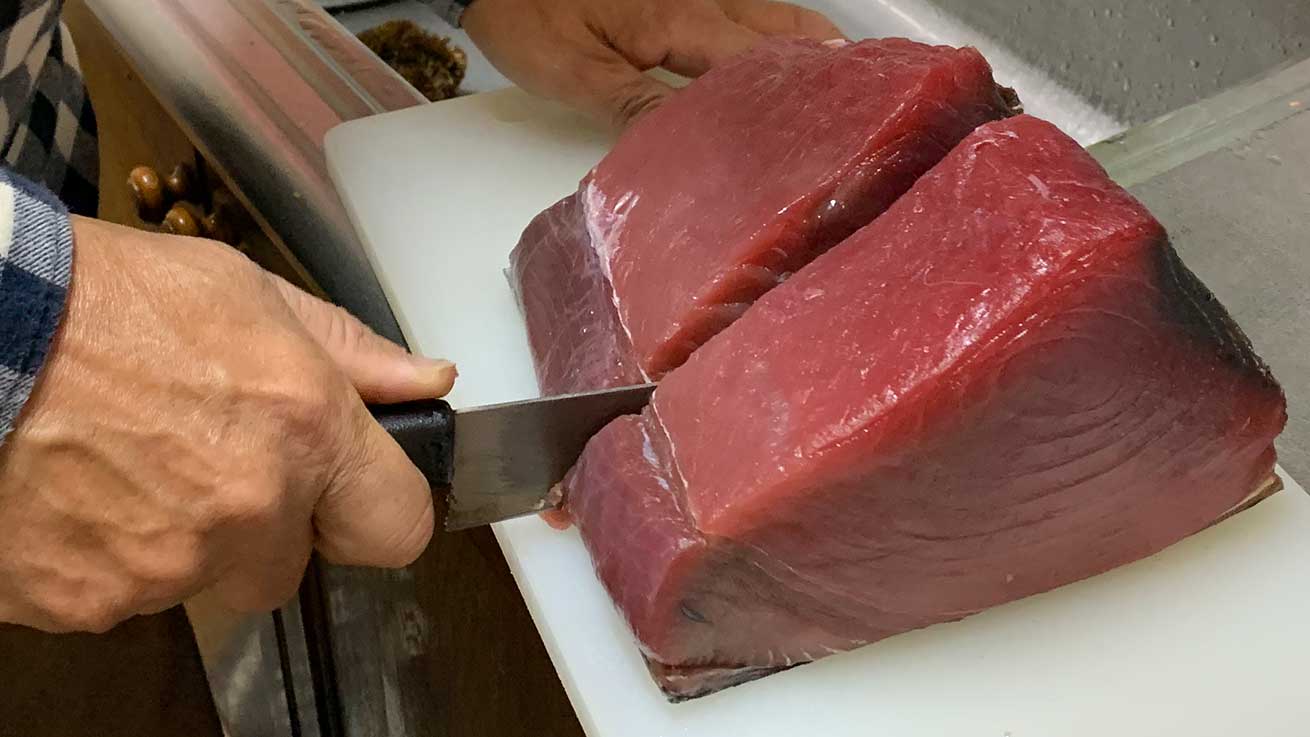
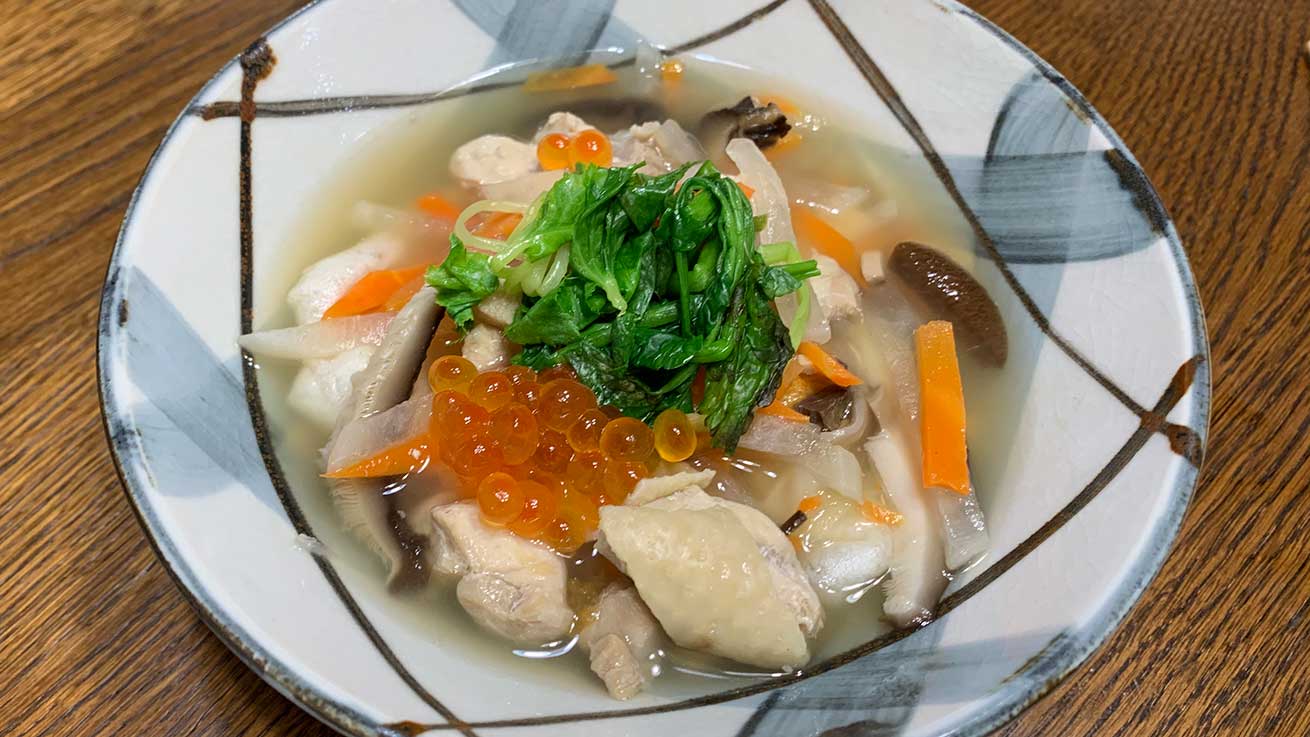
Fukubukuro
Fukubukuro means “lucky bag.” And January second is Lucky Bag Day in Japan. Think of it as our Black Friday; it is the biggest shopping day of the year in Japan. Fortified with good fortune and good food, and perhaps a bit stir-crazy by now, Japanese head out in droves to hit the stores. It can be both overwhelming and a lot of fun to observe the crowds.

While some lucky bags can be a bit disappointing, others are well worth it. A local tea shop in Ichbibancho Sunmall offers 10,000 Yen gift bags that people line up for hours. And the Fujisaki Department store has 25,000 Yen gift bags that are equally thought after. We may have to add some actual shopping to our traditional Japanese New Year’s.
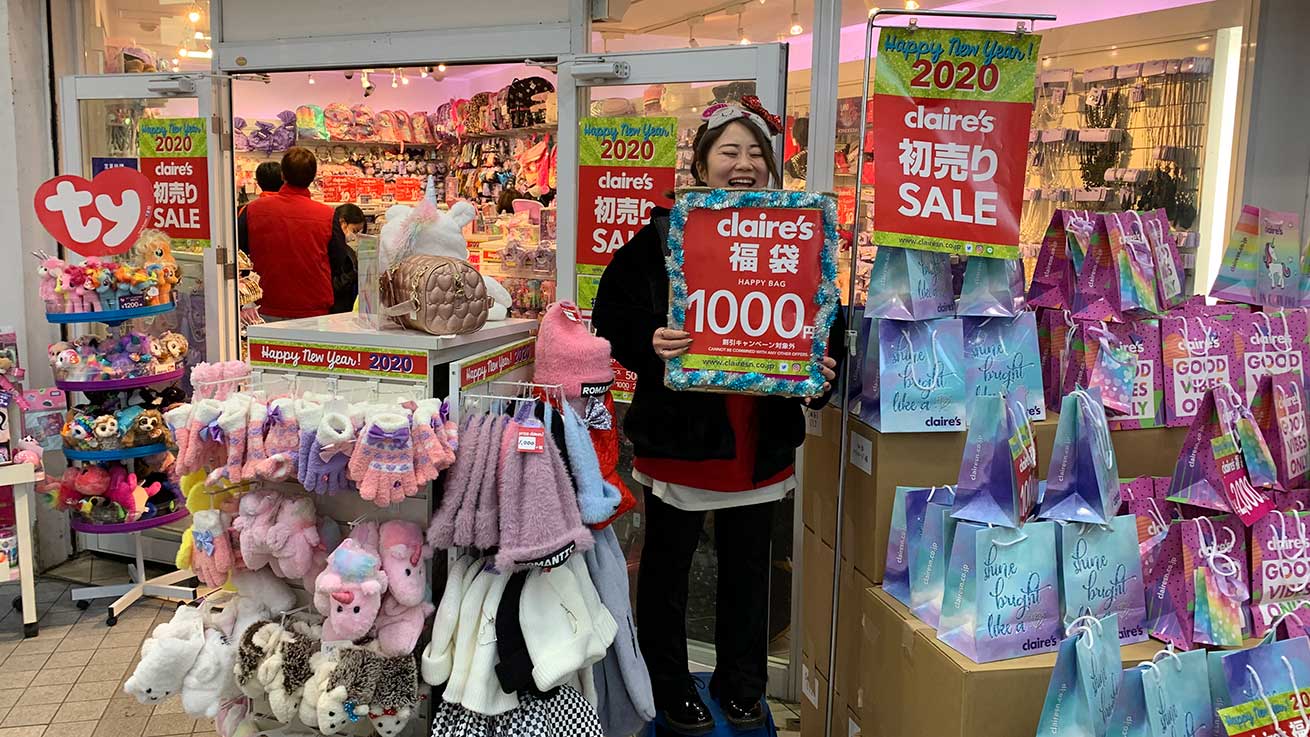
For now, we enjoyed watching all the people and taking in the excitement at our local shopping arcades. We checked out all the different lucky bags in the food court at the Mitsukoshi Department Store. Of course, that made us hungry, so we wrapped up our first traditional New Year’s in Japan with another favorite, yakitori!
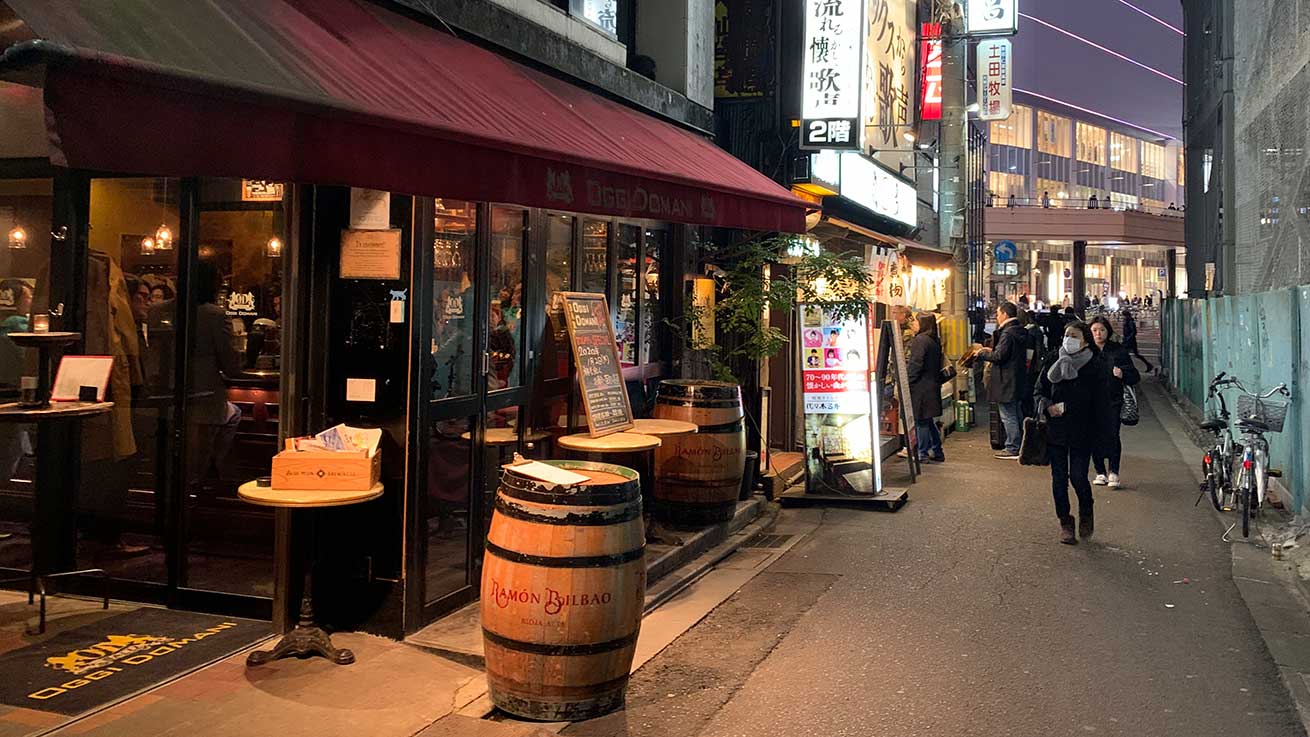
Our First Traditional Japanese New Year
As you can tell, we really enjoyed Oshogatsu. We always enjoyed this holiday, and we tried to observe it as much as possible in Seattle. Being with family, enjoying the different events, and participating in the traditional Shinto rituals had a special meaning for us this year. It marked the end of our first entire year in our new home and set the mood for our next adventures.
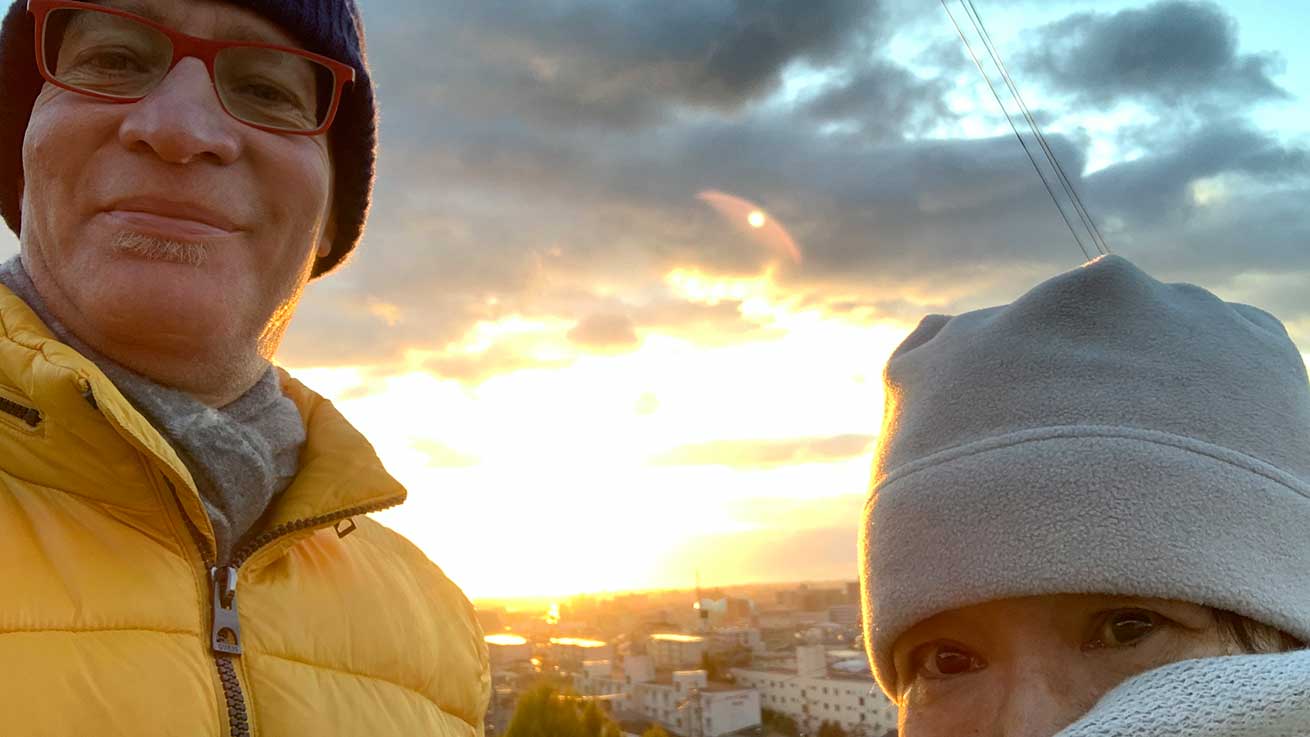
This year we included our friends in our prayers and offerings. Perhaps one year we can celebrate a traditional Japanese New Year with you.
In the meantime, we wish you much peace, fulfillment, and happiness for the Year of the Rat!
明けましておめでとうございます!
If you would like to join us for a tour to Discover Sendai, please feel free to contact us for rates and availability.
Happy Travels!

